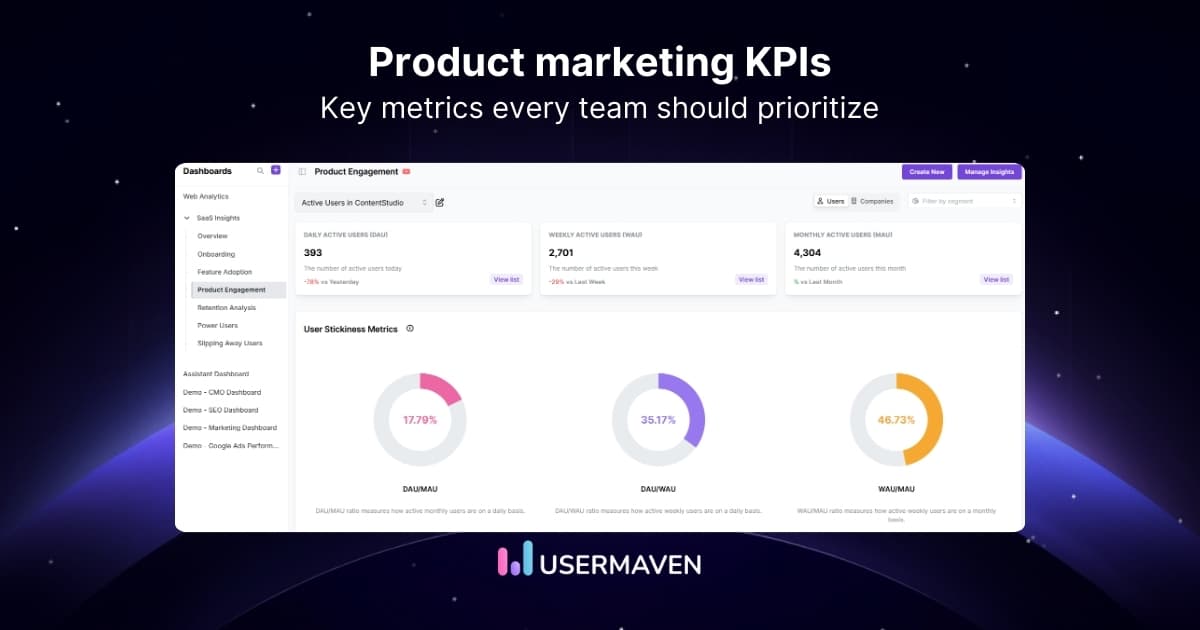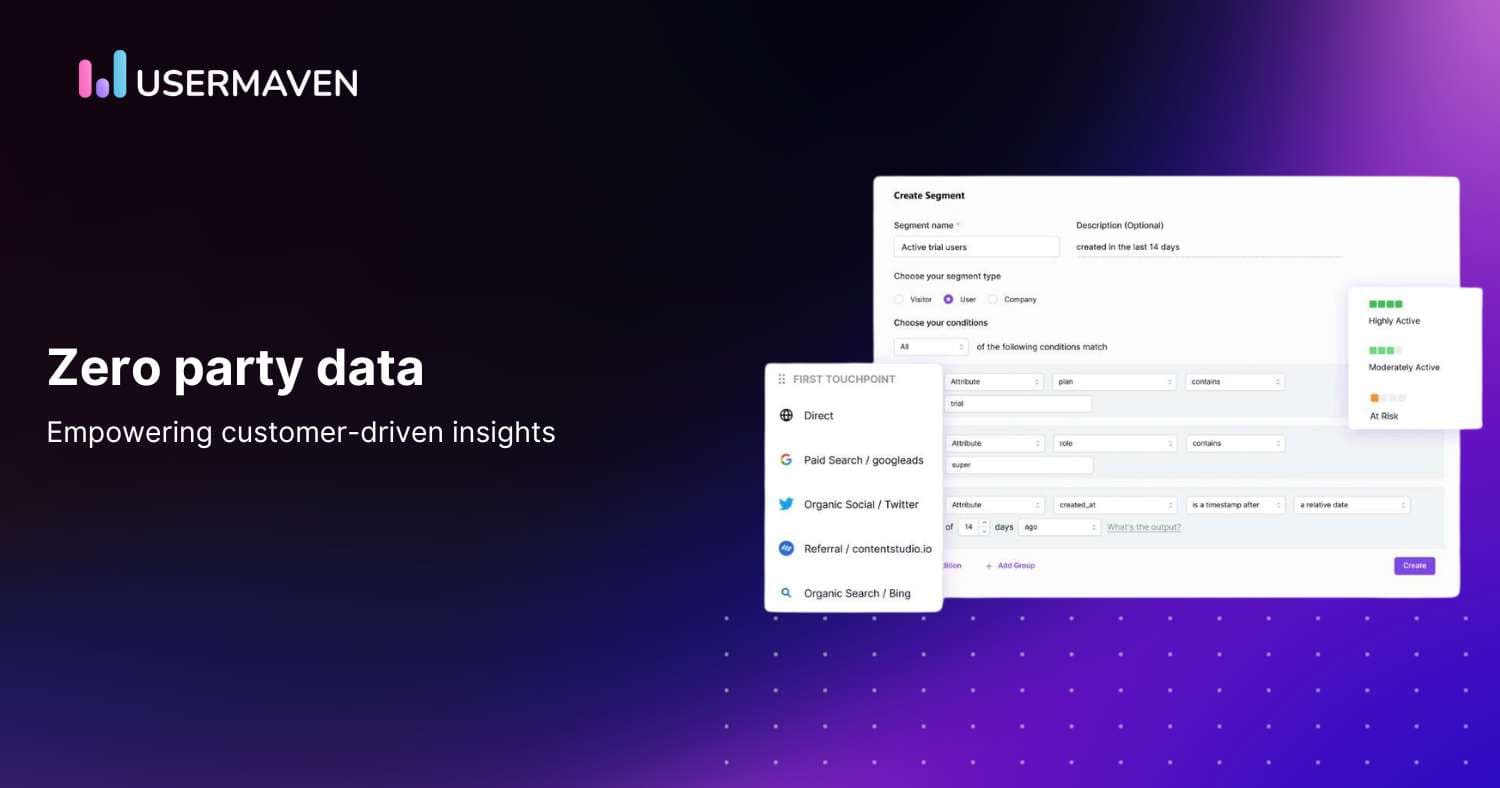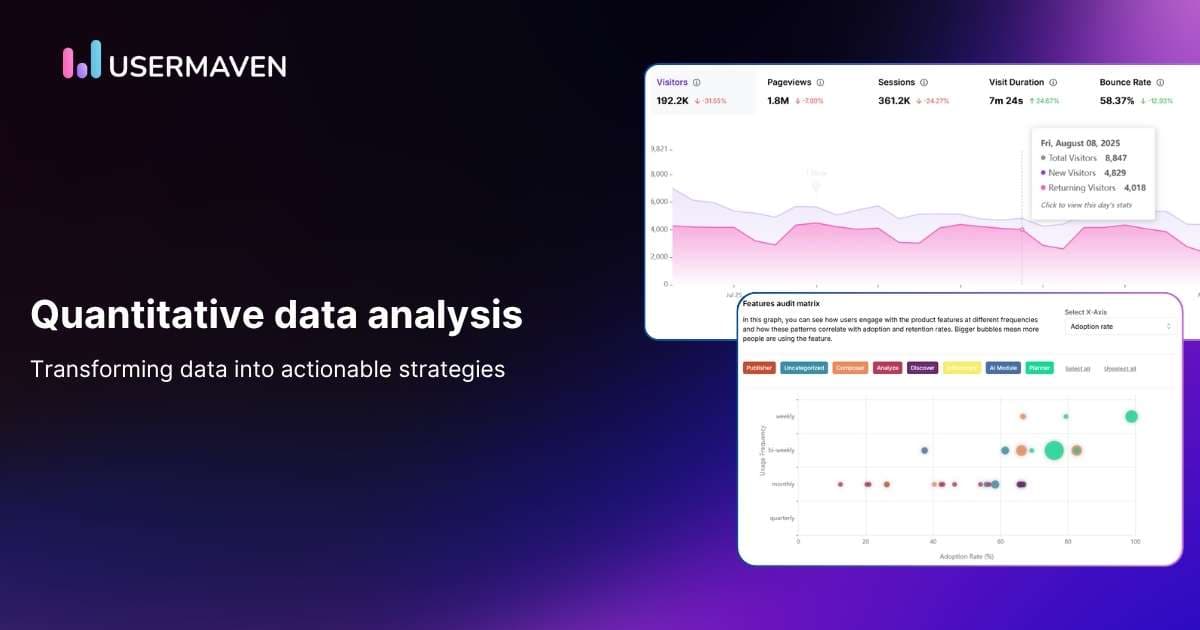Table of contents
SaaS product adoption curve: A complete guide for sustainable growth
Apr 28, 2025
6 mins read
Written by Mahnoor Shahid

Ever wondered why some SaaS products seem to take off overnight while others struggle despite amazing features? The secret lies in understanding the product adoption curve for SaaS businesses and strategically navigating each stage of this journey.
As a SaaS founder or product leader, mastering the product adoption curve isn’t just helpful – it’s essential for survival. Let’s dive into this fascinating framework and uncover how you can accelerate your path to widespread acceptance!
Understanding the SaaS product adoption curve fundamentals
The product adoption curve for SaaS represents the progression through which your solution gains acceptance in the market. Unlike traditional products, SaaS offerings experience adoption as an ongoing process rather than a one-time event. Each feature release, interface update, and pricing change effectively resets portions of the adoption curve, creating a dynamic ecosystem where customer engagement must be continuously nurtured and monitored.
The classic product adoption curve for SaaS divides the market into five distinct segments, each with unique characteristics and needs that significantly impact your product strategy, marketing approach, and growth trajectory.
The five segments of the SaaS product adoption curve
The adoption journey begins with the smallest but most enthusiastic segment and gradually expands toward more conservative users. Understanding each group’s distinct motivations and behaviors provides the foundation for effective product development and go-to-market strategies.

1. Innovators (2.5% of the market)
Who they are: These are your tech enthusiasts who get a rush from trying the latest SaaS products, often before they’re even fully baked. They’re like the friends who install beta software “just to see what breaks.”
What they care about:
- Being the first to discover something new
- Technical capabilities and innovation
- Direct access to your product team
- Bragging rights within their tech circles
How Usermaven helps: Tools like Usermaven can help identify these early innovators through behavioral analytics, showing you exactly who’s exploring every corner of your product and providing detailed feedback.
Pro tip: Innovators make fantastic early evangelists but terrible references for your mainstream customers. Their tolerance for bugs and complexity is astronomically higher than the average user!
2. Early adopters (13.5% of the market)
Who they are: These are your visionaries – the forward-thinking professionals who spot strategic opportunities in new SaaS solutions. They’re not just looking for shiny toys; they’re looking for competitive advantages.
What they care about:
- Solving meaningful problems in innovative ways
- Strategic advantages over competition
- Being perceived as thought leaders
- Quality over perfection
How Usermaven helps: With Usermaven’s user journey tracking, you can see exactly how early adopters use your SaaS product differently from innovators – focusing on value rather than novelty.

Pro Tip: Early adopters bridge the gap between tech enthusiasts and mainstream customers. Their success stories become your most powerful marketing assets when moving along the product adoption curve for SaaS!
3. Early majority (34% of the market)
Who they are: These are your pragmatists – methodical decision-makers who adopt new SaaS technology once it’s proven but before it becomes commonplace. They want solutions that clearly deliver value without disrupting their established processes.
What they care about:
- Proven solutions with established track records
- Integration with existing systems
- ROI and measurable business outcomes
- References from others in their specific industry
How Usermaven helps: Usermaven’s conversion funnels and attribution reporting help you prove to the Early Majority that your SaaS product delivers measurable ROI – exactly what they need to see before purchasing.

Pro tip: The transition from Early Adopters to Early Majority represents the infamous “chasm” in the product adoption curve that many SaaS products fail to cross. This is where you transform from a cool innovation to a trusted business solution!
4. Late majority (34% of the market)
Who they are: These are your conservatives – risk-averse professionals who prefer established SaaS solutions and adopt new technology primarily when competitive pressures or operational needs make it necessary.
What they care about:
- Stability and reliability above all else
- Simplicity and ease of implementation
- Comprehensive support options
- Lower costs than existing solutions
How Usermaven helps: Usermaven’s user feedback collection and feature usage analytics help identify which parts of your product are most intimidating to conservative users, allowing you to simplify the experience.

Pro tip: Don’t underestimate the buying power of the Late Majority on your product adoption curve! Though they take longer to convert, they often become your most stable, long-term SaaS customers with lower churn rates.
5. Laggards (16% of the market)
Who they are: These are your traditionalists – deeply skeptical of new SaaS technology and resistant to change unless absolutely necessary. They tend to adopt solutions only when they have no other choice.
What they care about:
- Preservation of existing workflows
- Absolute minimum disruption
- Extensive training and support
- Compliance with traditional industry standards
How Usermaven helps: Usermaven helps you identify friction points that might be barriers for laggards, allowing you to create simplified onboarding paths specific to these resistant users.
SaaS-specific factors influencing the product adoption curve
The unique characteristics of SaaS business models introduce several factors that significantly influence adoption patterns beyond the traditional curve. Understanding these elements is essential for developing effective strategies at each stage.
Freemium and product-led growth strategies
Unlike conventional products, many SaaS solutions offer freemium versions or self-service trials that fundamentally alter adoption dynamics in the product adoption curve for SaaS. These approaches create two distinct phases of adoption: initial product usage and conversion to paid subscriptions.
This dual-stage adoption process introduces several strategic considerations:
- Reduced adoption barriers: Free versions eliminate financial risk, potentially accelerating early-stage adoption
- Bottom-up penetration: Individual users can adopt solutions without formal procurement processes
- Usage-based qualification: Behavioral data helps identify high-value conversion opportunities
- Expansion revenue focus: Growth comes from converting free users to paid and expanding existing accounts
Usermaven provides detailed analytics on freemium-to-paid conversion within the SaaS product adoption curve, helping identify which features and usage patterns predict successful conversions. This intelligence allows for targeted interventions that accelerate movement through the adoption stages.
Network effects and collaborative features
Many SaaS products exhibit network effects – becoming more valuable as user numbers increase. Collaboration tools, marketplaces, and platforms with integration ecosystems all benefit from this phenomenon, which can dramatically affect progression through the product adoption curve for SaaS.
Network effects introduce several distinct adoption patterns:
- Accelerated adoption curves: Growth can become exponential rather than linear once critical mass is achieved
- Shortened chasm periods: Strong network effects can help bridge the gap between early adopters and early majority
- Organic growth drivers: User-to-user invitations create internal growth engines
- Increased switching costs: Network participation builds barriers to competitive displacement
Usermaven’s tracking capabilities can monitor viral invitation flows and identify which users most effectively bring others into your ecosystem. This intelligence enables optimization of referral mechanisms and targeted encouragement of users with the highest viral potential.
Continuous development and feature evolution
Unlike traditional products with discrete versions, SaaS solutions continuously evolve after initial adoption. This ongoing development creates a perpetual mini-adoption cycle for each new capability, requiring strategic feature introduction and adoption monitoring.
Continuous development introduces several considerations for the product adoption curve in SaaS:
- Feature-specific adoption strategies: Different capabilities may appeal to different segments
- Reactivation opportunities: New features can re-engage dormant users
- Incremental value demonstration: Each update provides an opportunity to demonstrate continued investment
- Adoption friction management: Changes must balance innovation with minimizing disruption
Usermaven’s feature usage tracking illuminates which new capabilities resonate with different segments along the product adoption curve for SaaS, enabling evolution based on actual usage data rather than assumptions. This intelligence helps prioritize development efforts and create targeted adoption campaigns for specific features.
Effective strategies for each stage of the SaaS product adoption curve
Maximizing growth requires tailored approaches for each segment of the adoption curve. The following strategies address the unique characteristics and needs of each customer group.

Innovator stage strategies
During the earliest phase of the product adoption curve for SaaS, focus on learning and validation:
- Create feedback mechanisms: Implement in-product channels for gathering insights
- Establish technical credibility: Develop robust documentation and transparent product roadmaps
- Build community connections: Create spaces where technical users can interact with your team
- Optimize for experimentation: Enable quick implementation and flexible configuration
- Leverage Usermaven analytics: Identify power users through behavioral tracking
Early adopter stage strategies
As you progress to visionary customers in the SaaS product adoption curve, shift focus to demonstrating strategic value:
- Develop success frameworks: Create structured approaches for measuring business impact
- Build customer advocacy programs: Formalize case study and testimonial processes
- Refine positioning: Articulate strategic value propositions for specific use cases
- Create exclusive communities: Connect forward-thinking customers for knowledge sharing
- Implement Usermaven’s journey tracking: Analyze how visionaries use product differently from innovators
Chasm-crossing strategies
Navigating the critical transition in the product adoption curve for SaaS requires:
- Focus on a specific vertical: Concentrate resources on dominating one market segment
- Develop complete solutions: Address all aspects of customer experience beyond core functionality
- Build strategic partnerships: Create relationships with trusted vendors in target markets
- Create implementation blueprints: Develop standardized approaches for common use cases
- Utilize Usermaven’s conversion analytics: Identify and address barriers preventing mainstream adoption
Early majority stage strategies
Engaging pragmatic buyers in the SaaS product adoption curve requires emphasizing reliability and proven outcomes:
- Enhance enterprise readiness: Develop robust security, compliance, and administration capabilities
- Build comprehensive integration ecosystem: Connect with established business systems
- Create industry-specific solutions: Tailor offerings to vertical market requirements
- Develop formalized customer success: Create structured onboarding and implementation methodologies
- Leverage Usermaven’s ROI tracking: Demonstrate concrete business value to pragmatic buyers
Late majority and laggard stage strategies
For conservative segments later in the product adoption curve for SaaS:
- Simplify user experience: Create streamlined versions with focused functionality
- Develop migration services: Create pathways from legacy systems
- Build comprehensive training: Create role-based education programs
- Implement high-touch support: Provide dedicated assistance for technology-averse users
- Utilize Usermaven’s friction analysis: Identify and address barriers for conservative users
Usermaven’s feature analytics for SaaS product adoption curve
Usermaven’s feature adoption analytics platform provides SaaS companies with in-depth insights into how users interact with specific product features. Unlike basic product analytics that track overall usage, Usermaven focuses on feature-level engagement patterns that reveal the true health of your product.
Key capabilities
Usermaven offers a robust set of tools designed to give product teams unprecedented visibility into how users engage with individual features, helping them make more informed decisions about product development.
Comprehensive feature tracking
- Monitor adoption rates across all product features
- Analyze usage frequency patterns (weekly, bi-weekly, monthly, quarterly)
- Compare adoption rates between different user segments

Advanced visualization
The platform transforms complex usage data into intuitive visual formats that make patterns and insights immediately apparent to product teams.
- Feature audit matrix displays the relationship between usage frequency and adoption rates
- Bubble size indicates relative user numbers engaging with each feature
- Visual indicators help identify your most successful and underperforming features
Detailed adoption metrics
Beyond surface-level engagement data, Usermaven provides granular metrics that tell the complete story of feature performance over time.
- Feature-specific usage statistics showing percentage of users engaging
- Adoption rate tracking to measure successful implementation
- Retention analysis to identify which features drive ongoing engagement
- Period-over-period comparisons to spot trends
AI-powered insights
Leveraging artificial intelligence, Usermaven automatically surfaces the most important patterns and opportunities that might otherwise remain hidden in the data.
- Automatic identification of top-performing features
- Usage pattern recognition across user segments
- Retention analysis highlighting concerning drops or impressive gains
- Custom recommendations based on your specific product data

Business benefits
By implementing Usermaven’s feature adoption analytics, product teams can make smarter decisions backed by concrete data rather than assumptions about user behavior.
- Identify which features truly drive value and retention
- Spot underperforming features that need improvement or retirement
- Understand how different user segments engage with your product
- Make data-driven decisions about feature development priorities
- Monitor the impact of product changes on adoption metrics
Feature-level analytics goes beyond surface metrics to reveal the actual engagement patterns that predict long-term success, helping product teams create more valuable, sticky products that users love.
Conclusion
Understanding the SaaS adoption curve helps you tailor strategies for each customer segment – from early adopters to the late majority. Success depends on continuously tracking adoption, adapting to changes, and making data-driven decisions using tools like Usermaven.
Remember, adoption isn’t a one-time event – new features create fresh adoption cycles. Stay focused on metrics, reassess your position often, and use insights to move confidently through the curve and drive long-term growth.
Power up your SaaS
with perfect product analytics
*No credit card required
FAQs about SaaS product adoption curve
1. What is the SaaS product adoption curve?
It’s a framework that shows how different types of users adopt a SaaS product over time – starting from innovators to laggards.
2. Why is the adoption curve important for SaaS companies?
It helps identify user behaviors and tailor product, marketing, and support strategies for sustainable growth.
3. Who are the five adopter segments?
Innovators, early adopters, early majority, late majority, and laggards.
4. What’s the biggest challenge in the adoption curve?
Crossing the “chasm” between early adopters and early majority – where many products fail to gain mass-market traction.
5. How can Usermaven support product adoption?
Usermaven provides feature analytics, conversion tracking, and journey insights to accelerate adoption across all user segments.
6. How do freemium models affect adoption?
They reduce entry barriers and allow bottom-up adoption but require strategies for converting free users to paid plans.
7. What role do network effects play in adoption?
They make the product more valuable as more users join, often accelerating adoption through viral growth.
8. How should product teams handle continuous feature updates?
By tracking feature-specific adoption, gathering user feedback, and managing change without overwhelming users.
9. What’s a key metric to monitor at each stage?
Feature engagement – knowing which features different user types value helps drive adoption and retention.
10. Can all SaaS products follow the same adoption strategy?
No. Each product needs a tailored approach depending on its market, audience, and stage in the adoption curve.
Try for free
Grow your business faster with:
- AI-powered analytics & attribution
- No-code event tracking
- Privacy-friendly setup


